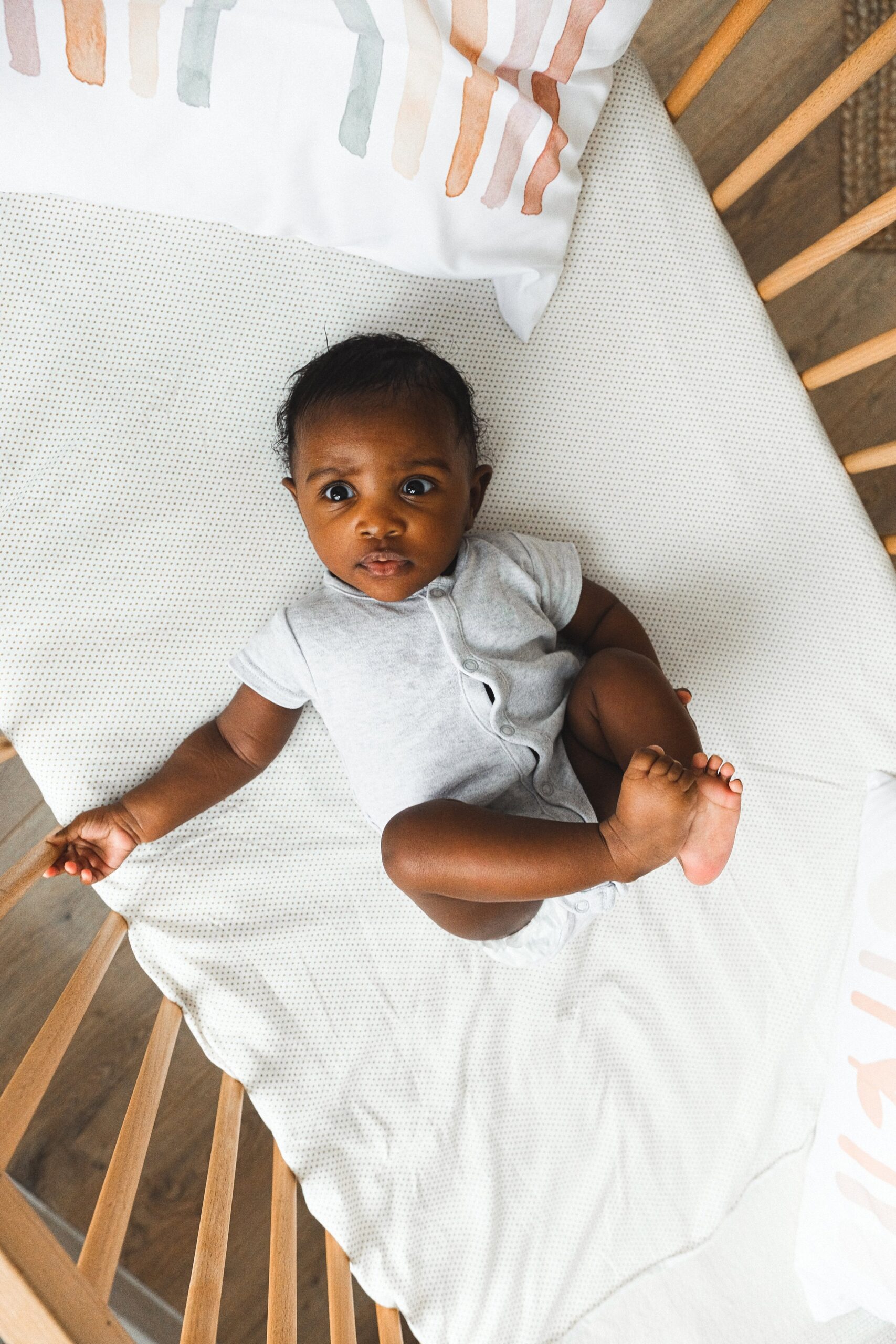I'm Rachael
Mom of 3 & Baby Sleep Expert with Big Sis Energy
& I’VE DONE ALL THE RESEARCH FOR YOU ALREADY.
Better sleep for the entire family
BROWSE COURSES
hey!
childcare: prepping your child and sleep, part 2
January 25, 2024
in this post:
Returning to work after maternity leave is a huge transitional period for both mother and baby. In Part 1 of this blog, we looked at how to prepare yourself emotionally and practically as you navigate this season and the inevitable emotions that arise. In Part 2 we will take a brief look at how to prepare your infant or child for starting childcare.

matchmake
-
Once you have chosen a setting or caregiver you want to “matchmake.” This means that you want to let your baby know that this person is safe to hand them off to. Your child will follow your lead and take cues from your body language.
-
Greet the care person warmly with a smile, light touch, conversation, or even a hug if appropriate before expecting your baby to go to them.
-
Let your baby warm up slowly and don’t force them into the hands of someone else if they are uncomfortable.
-
Have the new caregiver offer bids of connection by offering a hand, finger, smiles, conversation, toys, etc. first.
-
Talk about the caregiver positively and warmly at home to keep them in your child’s mind and thought of positively. You may even have a photo of them visible in your home.
connection at home
Re-connection time at home is so important for keeping stress low and helping your child feel connected and secure as they navigate through the transition.
-
For a baby this can look like – co-bathing, snuggles, eye contact, nursing or feeding while cuddled and distraction-free, baby massage, play, contact naps, babywearing etc.
-
For a toddler this can look like playing, having special time with stories, talking about their day, having dinner together, singing songs, lots of physical affection, co-sleeping or a weekend contact nap, rough and tumble type play, taking a walk or playing together, etc.
-
There is a lovely guide here for talking to your toddler about their day.
-
Make sure you offer quality time without being distracted by work or phones as much as you can so that your child can soak up having your full attention.
-
Focus on upping the connection in your bedtime routine with lots of touch, skin-to-skin, laughter, play, silliness, and giggles.
-
There are some great book recommendations here.
sleep
-
Many people get really anxious about how their baby/toddler will sleep with this new arrangement and panic about making changes and think they will need to stop bedsharing or co-sleeping etc. They may think they need to rush to find new ways of getting their baby to sleep if they nurse or rock at home. The opposite is true! Your baby/toddler will need this normalcy and connection time with you even more. They are already going through a huge change by starting childcare and may want more closeness to you. It’s totally OK and normal for them to fall asleep one way with you, and another way with a different caregiver.
-
One helpful tip is to add in additional sleep associations. For example, as you nurse them to sleep add in something else such as bum pats or rocking and swaying or sound such as “sssh,” humming, or singing/ playing songs. Talk with your childcare providers about using these sleep associations to help them get to sleep at your childcare if they are old enough to understand.
-
Make sure you talk through sleep with your chosen care provider to ensure they are practicing safe sleep (this includes supervised sleep under 6 months of age) and that you are comfortable with the sleeping arrangements they have. If you have opted for a nanny they may be able to contact nap if that is what works best for you.
-
Sleep may feel a bit rocky to begin with but they will adjust and they will find a way to sleep at daycare. The transition can take a few weeks, so don’t be discouraged if it’s a rough (and sleepy!) first few days.
-
For daycare centers that have a “one nap” policy, your baby may take a few weeks to adjust if they are under 12 months old. Most babies will not transition to 1 nap per day until closer to the 13-15 month range. If this is the policy and it can’t be changed, give your child some time to get used to the new schedule. You can try and let them sleep as early as they can in the morning before heading out the door, and know that they may take a little cat nap on the way home. Bedtime may need to be adjusted to accommodate this new schedule. You can keep the same schedule on weekends, but also know that you don’t have to be rigid. If 2-nap days happen when they’re home with you and 1-nap days happen at daycare, that’s OK. Remember this is a short season and soon they’ll be ready for the 1-nap per day schedule regardless of where they are!
-
If your little one has a hard time napping at daycare, their schedule may need to be adjusted until they feel more comfortable in the new setting. You may decide to let them take a late afternoon cat nap and a bit later bedtime. Some families will also allow their child to do a contact nap, car nap, etc. on a lunch break if the daycare is close by, if you use a nanny and work from home, etc. It’s OK to be flexible while your child is getting used to this new arrangement!
-
If the opposite is true, and a looooong nap at daycare is making it hard to get your child to sleep at night, request that they nap them in a high-traffic, bright or busy area if possible. Daycare centers are usually legally required to provide a nap and are not allowed to wake the children, so this can be one workaround. A doctor’s not can sometimes work as well. Otherwise you may have to surrender to late bedtimes and remember this is a short phase.
-
Above all, communicate! Always be open and honest with communication with your care provider so that you can be sure your baby is getting the rest they need. And remember that they want the best rest possible for them too- you’re a team!
feeding
Many people worry about the new changes to feeding that will naturally happen with a change in care provider.
-
Ensure that your provider knows how to do paced bottle feeding.
-
Practice bottle feeding at home at least a few weeks prior to starting at childcare – bottle refusal is a common concern that comes up when returning to work.
-
Play around with whether your baby needs the bottle feeding to feel more or less like breastfeeding. Some babies need it to be a completely difference experience and others need it to replicate the feeling of nursing as much as it possibly can. Do they like facing in or out? Do they like sitting up or being laid down?
-
Practice bottle feeding at home but if they are still refusing and older than 6 months you can try an open cup or if they are 8 months then you can try a cup with a straw.
-
Check out my “bottles” highlight on IG for lots more bottle feeding tips!
Saying goodbye
-
Always warn your child you are leaving. This helps ease separation anxiety, even if it seems like a better idea to sneak away to avoid them becoming upset.
-
A confident, calm, and connected goodbye is key. A long drawn-out goodbye focuses on the separation where whereas a calm, loving goodbye focuses on being reunited. Remind them of when you’ll see them and what you’ll do together.
‘Goodbye, love! Have a great day, I will see you after snack time.’
-
Practice this through role play at home, even if your baby isn’t vocal they will find the words reassuring. I have a story about a role-play scenario here if you need inspiration.
-
Practice short separations and returning at home with games such as peek-a-boo and hide and seek.
-
Drawing a visual schedule of their day like this can help them with knowing when you will be reunited.
-
Use social stories, read every day, to talk through exactly what will happen.
-
For toddlers or older children, offer a “kissing hand” for them to hold onto you during the day. Read “Invisible String” or “Smooch” to remind them you’re always connected, even when apart!
- For more on the importance of a gradual approach vs. a “drop and run” parting, listen to this episode of NOTU all about starting childcare.
The best thing you can do is to continue being a connected, responsive, and loving parent. Keeping your infant’s cup full will help reduce stress and ease the transition. You’ve got this!
Be sure to head to my Instagram page to see the “Childcare” highlight for more tips from the community!
binge reads
We think you'll love these
You deserve to the
baby stage, not just "survive it."
And you DON'T have to sacrifice your values, ignore your instincts, or force yourself to follow a method you don't align with just to get your baby back to sleep.
I’m here to help you create a restful, sustainable sleep environment that honors both your baby’s needs AND your own (without the stress OR the guilt!) because, no, you don’t have to choose between the two.
enjoy!
BABY SLEEP COURSES →
BABY SLEEP CONSULTS →
Wish you could help your baby sleep better without resorting to sleep training? Download my FREE guide to a good night’s sleep and learn 8 simple, science-backed tips for supporting your child’s needs.
Traditional sleep training methods don’t have to be your solution to better sleep.
SLEEP TRAINING ISN’T THE ONLY WAY TO GET GOOD SLEEP
Hey, I'm Rachael and Hey, Sleepy Baby is for parents who want to get their nights back, without sleep training their babies.
NO ONE TOLD US POD
explorING the untold truths of parenting


